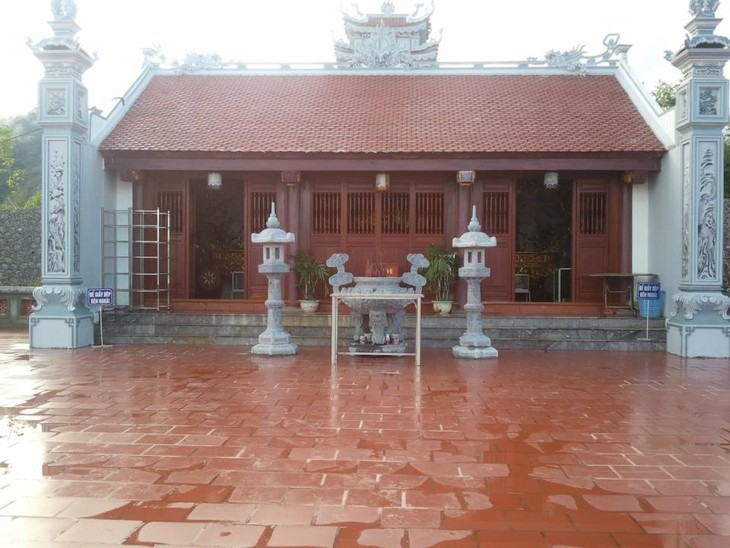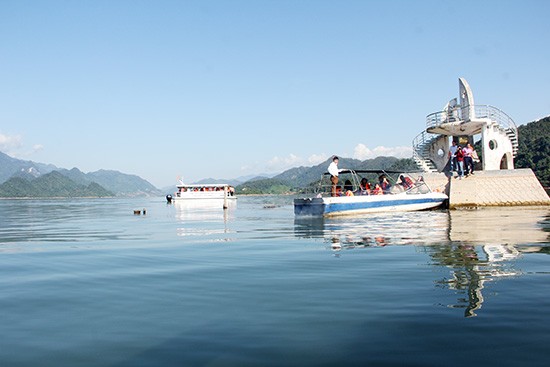(VOVWORLD) - Quỳnh Nhai district in Son La province is regarded as an inland Halong Bay in the northwestern region thanks to a 10,000-hectre hydroelectric reservoir and magnificent landscape. Local residents living on the two banks of the Đà river still preserve their colorful culture.
The first attraction for visitors to Quỳnh Nhai is a temple in Mường Giàng commune worshiping a female general called Han. Legend has it that Lady Han expelled invaders on the last day of a lunar year and ordered her soldiers to wash their hair and bathe in the river to welcome the new year and salute their victory. Since then, the hair washing ritual has become a tradition of the local white Thái people at year’s end to wash off all the difficulties, bad fortunes, and diseases in the waters while praying for a new year full of good luck, health, and bumper crops. Other activities are also held on the river for both visitors and locals.
 Han temple in Mường Giàng commune (Photo: quynhnhaionline) Han temple in Mường Giàng commune (Photo: quynhnhaionline) |
Điêu Chính Hiến, deputy head of the Culture and Information Office of Quỳnh Nhai district, said: “The Sơn La hydropower plant has created stunning views in Quỳnh Nhai which has been dubbed an inland Halong Bay. Tourists can take a yacht to enjoy the scenery of the Đà river at the beginning of the year when we also hold festivities such as a boat race on the 10th day of the first lunar month”.
The Pá Uôn bridge across the Đà river links Sơn La province with other northwestern provinces of Lai Châu, Điện Biên, and Lào Cai. From afar, the bridge looks like a white silk strip over blue water background. Pá Uôn bridge was recognized by the Vietnam Records Organization as the country’s highest abutment of 98.6 meters.
The most-awaited activity for tourists is taking a boat trip in the reservoir of the Sơn La hydropower plant, the biggest of its kind in Southeast Asia. Điêu Chính Hiến elaborated: “Before the hydropower plant was constructed, there had been only modest water flows creeping into the ravines. The plant, once completed, raised the water that flooded the ravines so we now can see only mountain peaks undulating above the water surface that look like islets in Halong Bay”.
The boat begins at Pá Uôn wharf and sails up the Đà river among the lime rocks, bringing tourists to a milestone on Cao Pô hill which is surrounded by water and where the Quỳnh Nhai TV transmission station used to be installed. The islets along the way are painted by magnificent colors: the green of the forest, yellow of the rice fields, and red of the stilt house tiles.
|
 Visitors take a boat tour in the Sơn La hydro-electric reservoir in Quỳnh Nhai district. Visitors take a boat tour in the Sơn La hydro-electric reservoir in Quỳnh Nhai district.
(Photo: baosonla.org.vn)
|
Vũ Anh Dũng, an official of Thuận Châu district’s Culture and Information Office, told VOV: “Tourism activities in the reservoirs include boat trips and games. Tourists can visit an on-site fisheries cooperative and enjoy local specialties like cơm lam (rice in bamboo tube), canh bon (a soup made of water taro), and riêu đá (crab soup)”.
The boat trip takes visitors to Bon village in Mường Chiên commune on a Đà river bank which is best known for its semi-inundated fields and stilt houses. They have a chance to experience traditional food, dances, and songs created by a characteristic instrument called the “tính tẩu”, as well as the hospitality of the white Thai ethnic group.
Nguyễn Thu Huyền, a visitor from Đà Lạt, said: “This is the first time I’ve toured the Sơn La hydroelectric reservoir on a boat. I find it tranquil yet majestic. I want to return to discover more about this place”.
The Sơn La hydroelectric reservoir has grown to be an attractive destination. Quỳnh Nhai district authority is working to operate more community-based tourist sites and services while preserving the local culture.